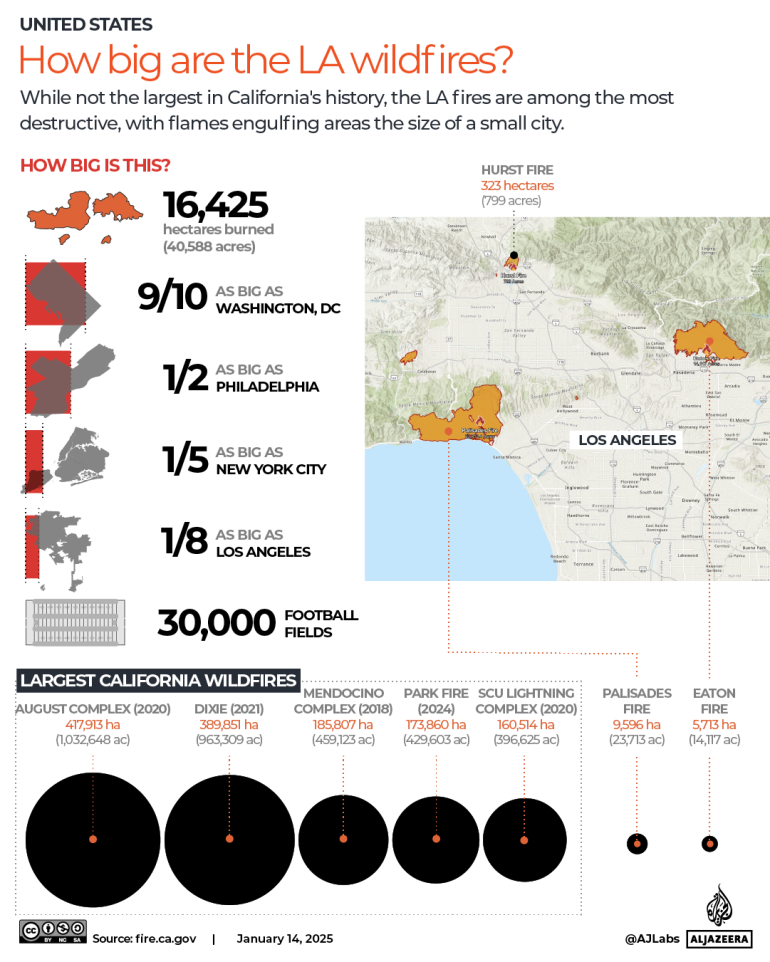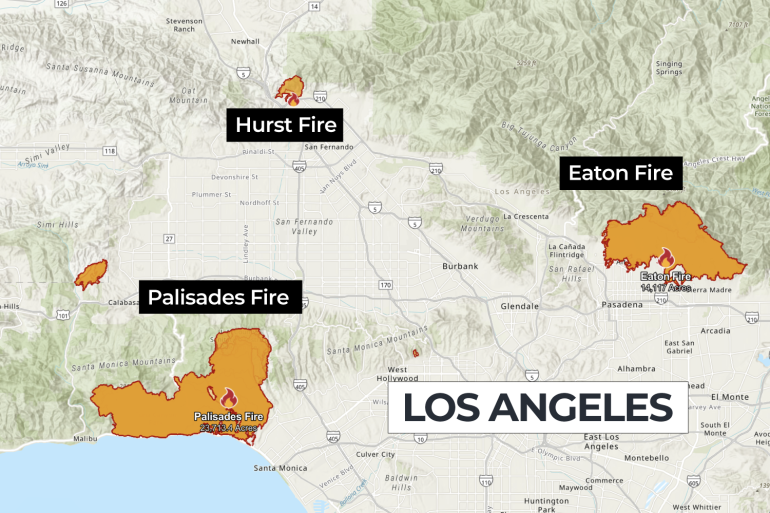The wildfires currently sweeping through Los Angeles have become the most destructive in the county’s history. With at least 12,300 structures destroyed and 24 lives lost, these fires are also on track to becoming the deadliest in LA’s history.
Fires Still Burning as of January 14, 2025
As of Tuesday morning, three of the six main fires in Los Angeles County remain active:
- Palisades Fire: 9,596 hectares (23,713 acres) burned, 14 percent contained. The fire swept through the affluent Pacific Palisades neighborhood, nestled between the Santa Monica Mountains and the Pacific Ocean, destroying at least 5,300 homes and forcing over 100,000 residents to evacuate.
- Eaton Fire: 5,713 hectares (14,117 acres) burned, 33 percent contained. This fire engulfed large parts of the Altadena area, destroying over 5,000 structures.
- Hurst Fire: 323 hectares (799 acres) burned, 97 percent contained. While smaller, the fire posed significant challenges before nearing containment.
The Kenneth, Lidia, and Sunset fires have been fully contained, offering some relief amidst the chaos.
The Scale of the Fires
Combined, the ongoing fires have burned 16,425 hectares (40,588 acres) of land. To put this into perspective:
- About the size of Washington, DC
- Half the size of Philadelphia
- Roughly equivalent to 30,000 football fields
California typically experiences thousands of wildfires annually, but the destruction caused by the 2025 fires places them among the most devastating in recent history.

A Historical Context for Destruction
The Palisades and Eaton fires have collectively destroyed over 10,000 structures, making them the most destructive wildfires in Los Angeles County’s history. In California as a whole, they are second only to the 2018 Camp Fire in terms of destruction.
The ongoing fires stand out not just for their size but also because they have struck densely populated areas. The Camp Fire, which remains California’s deadliest with 85 fatalities, burned through the sparsely populated town of Paradise in Butte County. In contrast, the 2025 fires have wreaked havoc in urban and suburban Los Angeles County.
Causes of Destruction
- High Winds: Persistent strong winds have made containment difficult, spreading embers far and wide to ignite new areas.
- Drought and Dry Conditions: California’s prolonged drought has turned vegetation into a tinderbox, fueling rapid fire spread.
- Urban Density: Unlike rural areas often hit by wildfires, Los Angeles County’s dense population increases the risk of property destruction and casualties.
According to the Los Angeles County Coroner’s Office, 16 of the 24 recorded deaths have been attributed to the Eaton Fire, while the Palisades Fire accounted for the remaining eight fatalities.
Lessons from Past Wildfires

California’s history offers grim reminders of the potential for catastrophic wildfires. The 2018 Camp Fire devastated Paradise, destroying 18,000 structures over 62,000 hectares (153,000 acres). It was caused by faulty electrical transmission lines and caught many residents off guard due to its rapid spread.
Earlier disasters like the 1933 Griffith Park Fire, which left 29 dead in Los Angeles, also underscore how deadly these events can be. Despite advances in evacuation protocols and firefighting techniques, the 2025 fires reveal the ongoing challenges posed by climate change, urban sprawl, and aging infrastructure.
Economic Impact
AccuWeather estimates the total economic cost of the 2025 wildfires to be between $135 billion and $150 billion. This includes:
- Direct property losses
- Firefighting expenses
- Indirect economic effects, such as business closures and displaced residents
Looking Ahead
As firefighters continue to battle the flames, residents are urged to remain vigilant and adhere to evacuation orders. The ongoing crisis highlights the urgent need for climate mitigation strategies, infrastructure modernization, and community preparedness.
These fires are a stark reminder of California’s vulnerability to natural disasters, emphasizing the importance of proactive measures to protect both lives and livelihoods. While the flames may eventually subside, their impact will be felt for years to come.



